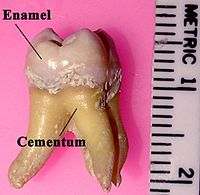
Photo from wikipedia
BACKGROUND Sickle cell disease (SCD) is the most important hemoglobinopathy in terms of frequency and social impact and can affect the stomatognathic system. AIM To assess and compare the developmental… Click to show full abstract
BACKGROUND Sickle cell disease (SCD) is the most important hemoglobinopathy in terms of frequency and social impact and can affect the stomatognathic system. AIM To assess and compare the developmental defects of the enamel (DDE) in children and adolescents with and without SCD DESIGN: This was a cross-sectional, analytical, and comparative study of 210 children and adolescents aged 5-18 years, who visited the Hematology and Hemotherapy Hospital of Pernambuco. RESULTS DDE was observed in 55.2% of the SCD patients and 35.2% of the non-SCD patients (healthy group) (p < 0.05). In the SCD group, DDE was more common in females than in males (69.1% vs. 40.0%; p < 0.05). The incidence of DDE in the permanent teeth was higher in the upper arch than in the lower arch (SCD group, 13.1% vs. 4.6%; healthy group, 8.9% vs. 3.6%; p < 0.05). CONCLUSION Compared to the healthy group, the SCD patients were almost twice as likely to develop DDE, mostly affecting females and the permanent teeth. These findings suggest that individuals with SCD need early dental care to avoid future oral problems.
Journal Title: International journal of paediatric dentistry
Year Published: 2023
Link to full text (if available)
Share on Social Media: Sign Up to like & get
recommendations!